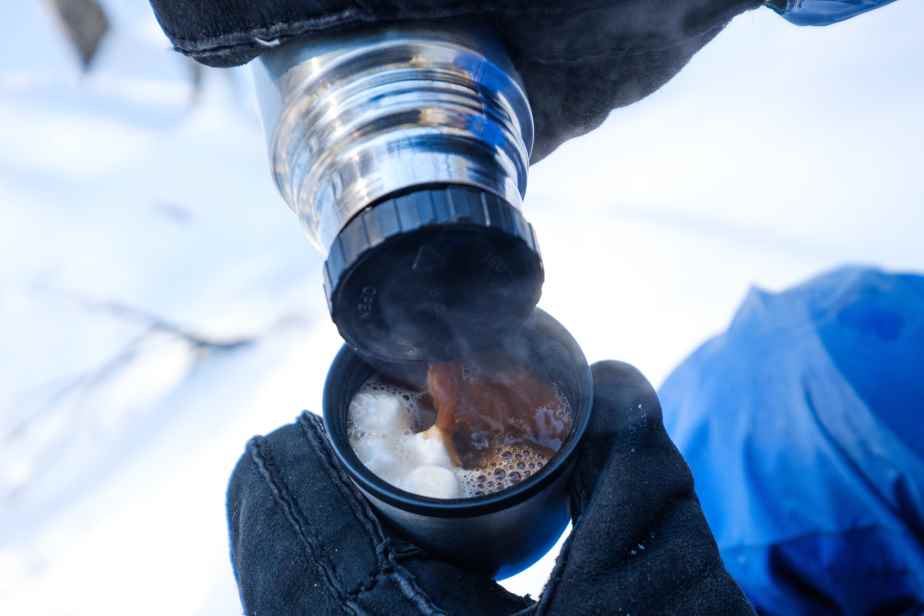Even though the cold is back, outdoor enthusiasts continue to explore the forests, rivers, lakes and mountains. They have a secret weapon: an insulated bottle filled to the brim with a liquid that warms the body and mind. Whether it’s for coffee, tea, hot chocolate or soup, a good old insulated container (thermos type) is essential.
However, there is something new in the world of the insulated bottle. In particular, there are many more choices.
The giant Thermos is still very present, especially in large chains like Canadian Tire and Walmart. “We all know the brand, it’s very good, but now,” there are other trends, says Hugues Grenier, campsite manager at the La Cordée store on Sainte-Catherine Street in Montreal. “People are turning to brands like Hydro Flask, Klunken and Yeti. »

PHOTO FROM THE CORDÉE WEBSITE
Primus Klunken bottle with handle, 500 ml, La Cordée, $23.99
A lot of choices
Whatever the brand, insulated bottles follow the same logic: a double wall in stainless steel to keep liquids at the initial temperature. Outdoors, we don’t really use the old technology anymore, which consisted of a glass container placed in a steel or plastic container.
Hydro Flask claims its bottles can keep hot for 12 hours or cold for 24 hours. However, it should be realized that when you pour yourself a cup of hot chocolate, cold air enters the bottle and helps to cool the remaining liquid somewhat. It is therefore difficult to retain heat for the promised 12 hours.

PHOTO FROM CANADIAN TIRE WEBSITE
Food container, 454 ml, Canadian Tire, $33.99
There are various formats, depending on the type of drinker involved.
“Is it someone who wants his little coffee to start the day or does he want to drink all day? asks Mr. Grenier.
There are bottles with large necks, small necks, straws. Runners, for example, will prefer a bottle with a straw, which is easier to use.
There are also models with a handle on the top which facilitates transport.
“There are interchangeable caps, notes Mr. Grenier. You don’t need to buy four different bottles, you can just change the caps. »

PHOTO FROM SAIL WEBSITE
Rambler bottle, by Yeti, 532 ml, SAIL, $40
However, in general, models from Hydro Flask, Kunken and Yeti do not provide an insulated cap that turns into a tumbler, a feature offered by brands like Thermos, GSI and Stanley.
A cup makes it easier to share between hikers. This is also an important feature for someone who, for example, wants to add mini marshmallows to their hot chocolate. You have to do this delicate operation just before drinking, in a cup, otherwise the marshmallows will melt and disappear into the depths of the insulated bottle.
Other advantages
“The non-slip exterior coating is very pleasant to have in your hand,” emphasizes Hugues Grenier. There is also an incredible variety of colors. You could almost match your water bottle with your backpack! »
He notes that there are ultralight models for hiking or cross-country skiing. “They are thinner, the cap is lighter, the coating is different,” says Mr. Grenier. Wherever they can cut, they cut. But they have the same insulating properties. »

PHOTO FROM MEC WEBSITE
Kids Hydro Flask Bottle with Straw Lid, 355ml, MEC, $35.95
There are also models for children, which are easier to hold due to their size and an even more non-slip base.
Classic brands and new players also offer insulated containers for food. It can be very pleasant to shove a hot chili or macaroni and cheese during the lunch break while the comrades are content with a half-frozen sandwich.

PHOTO FROM THE CORDÉE WEBSITE
The classic Thermos brand thermos, 470 ml, La Cordée, $29.99
Even when it’s colder, it’s important to stay well hydrated outdoors. There are insulated bottle holders that can prevent water from freezing too quickly in a Nalgene type bottle. There are also neoprene sleeves that cover the hose with hydration packs — like the CamelBak. We are still talking here about delaying freezing, because when it is -20°C, the sleeve is no longer enough. A bottle in its bottle holder will last much longer. And there will always be the good old insulated bottle.
Suggested video
Migration
A few weeks ago, a huge herd of pronghorn antelope was migrating through Wyoming.
digit of the week
408 km/h
It is the most violent gust ever recorded. It was April 10, 1996, in Barrow Island, Australia, during the passage of the cyclone Olivia.
